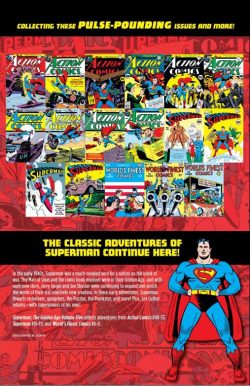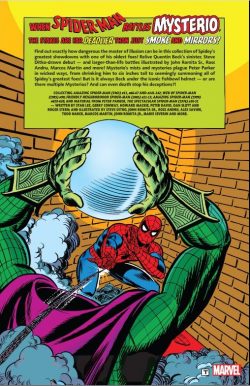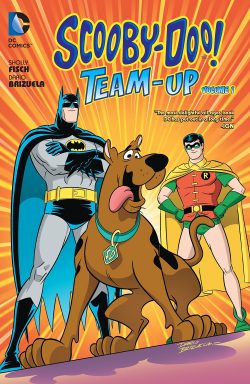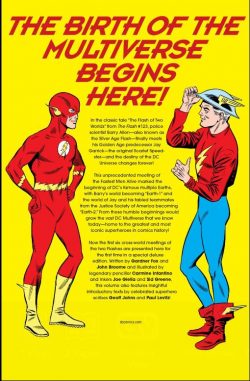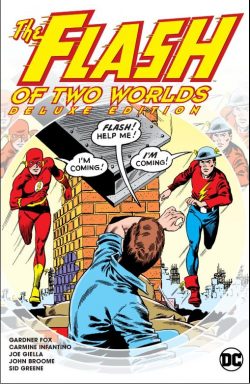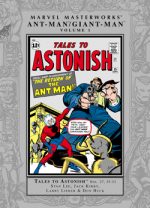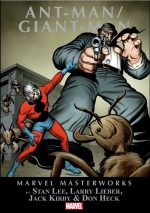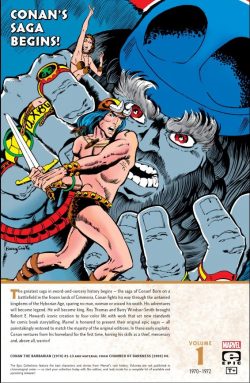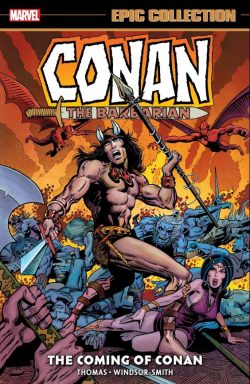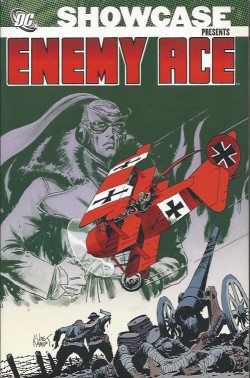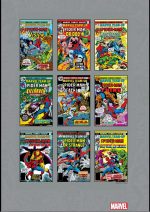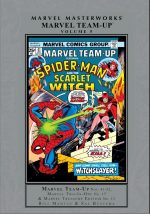
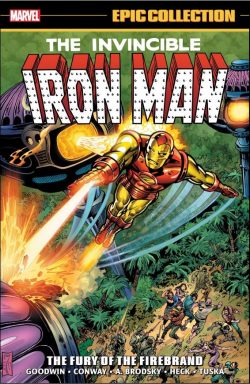
By Archie Goodwin, Gerry Conway, Allyn Brodsky, Mimi Gold, Robert Kanigher, Gary Friedrich, Johnny Craig, Don Heck, George Tuska, Herb Trimpe, Gene Colan & various (Marvel)
ISBN: 978-1-3029-2207-8 (TPB)
Win’s Christmas Gift Recommendation: A Glittering Bauble of Shiny Nostalgic Marvel Madness… 8/10
Created in the aftermath of the Cuban Missile Crisis and at a time when “Red-baiting†and “Commie-bashing†were American national obsessions (just like now), the emergence of a brilliant new Thomas Edison, using Yankee ingenuity and invention to safeguard and better the World, seemed inevitable. Combined with the then-sacrosanct belief that technology and business could solve any problem with the universal imagery of noble knights battling evil, the concept behind the Invincible Iron Man seems an infallibly successful proposition.
Of course, where once Tony Stark was the acceptable face of 1960s Capitalism: a glamorous millionaire industrialist/inventor and a benevolent all-conquering hero when clad in the super-scientific armour of his metal alter-ego, the tumultuous tone of changing times soon resigned his suave, playboy image to the dustbin of history and, with ecological disasters and social catastrophe from the abuse of industry and technology the new mantras of the young, the Golden Avenger and Stark International were soon confronting some tricky questions from the increasingly socially conscious readership.
All of a sudden maybe that money and fancy gadgetry weren’t quite so fun or cool anymore…?
This sterling hardback – and eBook – compilation covers the period May 1970 through May 1972, re-presenting Iron Man #25-46 and incorporating a tumultuous team-up with the Man Without Fear from Daredevil #73 which held a key portion of a rather complex comics crossover.
Imminently departing scripter Archie Goodwin pins Iron Man’s new Green colours to the comic’s mast in #25’s stunning eco-parable ‘This Doomed Land… This Dying Sea!‘, ably assisted by EC legend Johnny Craig, whose slick understated mastery adds a sheen of terrifying authenticity to proceedings. Here, the Armoured Avenger clashes and ultimately teams with veteran antihero Namor the Sub-Mariner, before being compelled to destroy one of his own hyper-polluting facilities, consequently overruling and abandoning his company’s previous position and business model…
Tragically, his attempts to convince other industry leaders to do likewise meets with the kind of reaction that tragically then (and again now) typifies America’s response to the real-world situation…
Original Iron Man artist Don Heck returned for the fantasy-fuelled romp ‘Duel in a Dark Dimension!’ (scripted by Goodwin and inked by Craig) with guest villain The Collector kidnapping Stark’s right-hand man Happy Hogan in a convoluted scheme to secure an extradimensional super-sword…
America’s mounting racial tensions took centre-stage in ‘The Fury of the Firebrand!’, introducing an inflammatory radical with a secret and highly personal hate-filled agenda aimed squarely at Stark and the fat cats he represented. The incendiary fiend was also a human napalm grenade…
Goodwin bowed out with #28’s riotous return match ‘The Controller Lives!’, wherein the mind parasite attacks Stark and SHIELD agent Jasper Sitwell through an old girlfriend, after which Mimi Gold scripted an old-fashioned commie-buster yarn, drawn by Heck and inked by Chic Stone in #29, with Iron Man liberating a tropical paradise from its enslaving socialist overlords in ‘Save the People… Save the Country!’.
Impressive new kid on the block Allyn Brodsky took over as scripter with #30’s ‘The Menace of the Monster-Master!’: a rousing rampage full of Maoist menace with a giant lizard ravaging Japan until the Golden Avenger steps in, taking charge and exposing a cunning plot…
Far more intriguing is ‘Anything… For the Cause!’ wherein back-to-nature hippie protesters and outraged teen radicals are manipulated by an unscrupulous local businessman. This social drama also adds cool young Irish science nerd Kevin O’Brian to the regular cast.
IM #32’s ‘Beware… The Mechanoid!’ (illustrated by George Tuska & “Joe Gaudiosoâ€) then relates a salutary tale of a benign alien explorer making the tragic mistake of exploring America whilst disguised as a black man…
Heck & Gaudioso (actually moonlighting Mike Esposito) handled the art for ‘Their Mission: Destroy Stark Industries!!’as corporate raider Spymaster unleashes his Mission: Impossible-inspired team The Espionage Elite to deprive America of both the inventor and his company. This fast-paced thriller concluded in bombastic finale ‘Crisis… and Calamity!!’with the near-death of a cast regular, signalling the advent of a darker, more driven Armoured Avenger…
Something of a comics wunderkind at this time, Gerry Conway assumed the writer’s reins in Iron Man #35 as the traumatised hero understandably seeks ‘Revenge!’ on Spymaster before being distracted by an ongoing battle between Daredevil, Nick Fury, Madame Masque and the global criminal network Zodiac – all contesting ownership of an extra-dimensional wish-granting super-weapon.
That battle spills over into Daredevil #73 and a mass abduction into another dimension in ‘Behold… the Brotherhood!’(by Conway, Gene Colan & Syd Shores) before messily and inconclusively concluding halfway through Iron Man #36 (Heck & Esposito). The remainder of the issue and battle for the Zodiac Key is necessarily shelved as the Steely Centurion is waylaid by terra-forming aliens in ‘…Among Men Stalks the Ramrod!’
Incapacitated and with his recently transplanted new heart critically damaged, Stark reveals his secret to Kevin O’Brian ‘In This Hour of Earthdoom!’ (Jim Mooney inks) before rapidly retrenching, recuperating and ultimately repelling the invaders. The fantastic fantasy drama pauses here for a hard-boiled and pleasantly low-key diversion in the form of an engaging gangster caper from Conway, Tuska & Esposito wherein Iron Man is forced to respond quite assertively ‘When Calls Jonah…!’
Conway resumes the mad science tales – with Herb Trimpe illustrating – in ‘A Twist of Memory… a Turn of Mind!’, wherein insidious oriental mastermind White Dragon (Yes, I know, but social relevance clearly advanced at its own piecemeal rate and racial profiling was less obvious than poisoned air and rivers…) deviously turns Stark into a brainwashed pawn, thereby inadvertently enslaving the Golden Avenger too.
Devoted assistant Kevin O’Brian comes to the rescue, but is led down a path to inevitable doom when he assists his mind-locked employer in a torturous ‘Night Walk!’ (by Tuska & Jim Mooney) to save his sanity and defeat the sinister foe.
Simultaneously, Marianne Rodgers, a woman they both love, begins a slow glide into madness as her telepathic powers gradually grow beyond her control and start eating at her mind…
Issue #41 continued a convoluted storyline dealing with mystery mastermind Mr. Kline. (For the full story you should also track down contemporaneous Daredevil and Sub-Mariner issues: you won’t be any the wiser but at least you’ll have a full set…)
Next, ‘The Claws of the Slasher!’ sees squabbling saboteurs target Washington DC during a Senate investigation into Stark Industries; accidentally triggering a psychic transformation in Marianne, who temporarily morphs into a mind-warping harpy in ‘When Demons Wail!’ (inked by Frank Giacoia). The clash culminates in a blockbusting, extra-long battle against psionic godling Mikas in ‘Doomprayer!’ (with Mooney inks). During that cataclysmic conflict O’Brian dons his own super-armour to join the fray as The Guardsman; causing his own mental state to rapidly deteriorate and making his eventual showdown with Stark utterly unavoidable…
Plotted by Conway, scripted by DC A-Lister Robert Kanigher and illustrated by Tuska & Vince Colletta, Iron Man #44 finds Stark near death after his last battle. In ‘Weep for a Lost Nightmare!’, he is watched over by Kevin and Marianne as Kline dispatches a robotic copy of old adversary The Night Phantom to finish the ailing hero off. The tale was truncated midway and completed in the next issue – presumably due to deadline problems.
Gary Friedrich scripted concluding chapter ‘Beneath the Armour Beats a Heart!’ in #45, after which Stark faces a revolt by his own Board of Directors who convince the jealousy-consumed O’Brian to stand with them.
When student protestors invade the factory, greed-crazed capitalist and reactionary revolt instigator Simon Gilbertconvinces O’Brian to don his Guardsman suit and teach the kids a lesson, leading to a horrific escalation in ‘Menace at Large!’ (inked by John Verpoorten) wherein Iron Man intervenes to save lives and causes the fully-amok O’Brian’s death…
To Be Continued…
The galvanised wonderment also includes the covers of Iron Man Annuals #1 and 2, a selection of house ads and a gallery of original art covers and interior pages by Marie Severin & Sam Grainger, Sal Buscema, Tuska and Frank Giacoia, to wrap up this collection with the Golden Gladiator carefully politically repositioned at a time when Marvel solidly set itself up at the vanguard of a rapidly changing America increasingly at war with itself.
With this volume Marvel further entrenched itself in the camp of the young and the restless, experiencing first hand, and every day, the social upheaval America was undergoing. This rebellious teen sensibility and enhanced political conscience permeated the company’s publications as their core audience evolved from Flower Power innocents into a generation of acutely aware activists. Future tales would increasingly bring reformed capitalist Stark into many unexpected and outrageous situations…
But that’s the meat of another review, as this engrossing graphic collection is done. From our distant vantage point the polemical energy and impact might be dissipated, but the sheer quality of the comics and the cool thrill of the eternal aspiration of man in perfect partnership with magic metal remains. These superhero sagas are amongst the most underrated but impressive tales of the period and are well worth your time, consideration and cold hard cash…
© 2020 MARVEL.

